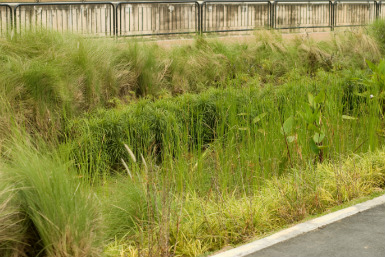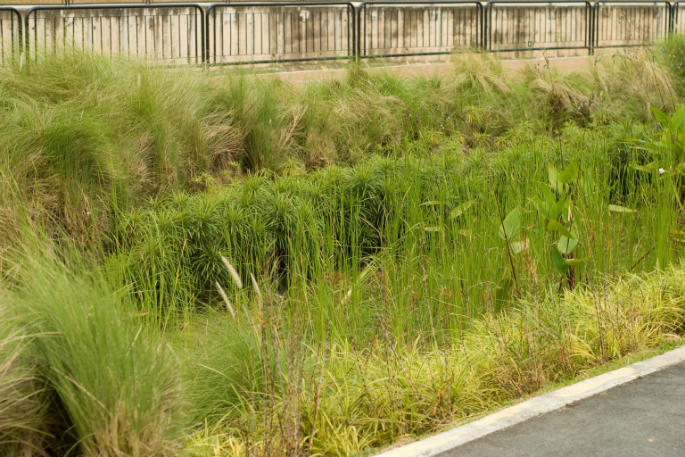In any given area, the natural habitat is supported by the natural hydrologic cycle of precipitation, evaporation, infiltration, and surface runoff. These processes are connected to the regional water resources, whether they are aquifers that support well water, or surface water resources including streams, rivers, ponds, and lakes that support wildlife habitats, commerce, recreation, and water supplies for our population centers. Basically, any time we convert natural areas — wooded, grassed, or otherwise vegetated land — into a development for residential, commercial, industrial, or infrastructure purposes, we are displacing some portion of that surface, altering the contribution to the natural water system, and potentially introducing pollutants. An individual development by itself wouldn’t significantly change the general characteristics of the regional water resources, but when economic interests drive large-scale developments that convert large areas without consideration for the natural resources, the impact can be evident. By introducing various design principles and control measures, our developments can allow practical use of the developed property while minimizing or even improving the contribution to the regional environment.


When it comes to implementing measures to achieve LEED certification, many of the sustainable site elements are a function of the site location, development footprint, and connectivity to the local community. However, probably the most challenging design elements are going to be those addressing stormwater controls that affect the quality, quantity, and total volume of water. Historically, these included retention or detention ponds with controlled outlet, but more recently they could include measures such as bioswales, rain gardens, permeable pavement systems, infiltration chambers, or mechanical filtration structures.
The focus on preserving natural resources has caused a departure from traditional design practices and has brought about revisions in many local design requirements. This has encouraged many entities, including construction material suppliers and biologists, to provide input on new design strategies, mechanical systems, and other proprietary solutions in order to help designers and owners meet these requirements. Between the changes in requirements and the various new solutions being presented, many engineers and local building officials have found themselves in unfamiliar waters. They may be uncertain as to what designs are acceptable, especially if they are based on the most highly publicized solutions — rain gardens, bioswales, permeable pavements, and various other more common filtration or mechanical treatment systems.
While it is largely up to the owner and end-users of the facility to implement the appropriate measures to achieve various goals, the design engineer needs to make sure the client is adequately informed to order to make the best decision and understand the consequences.
The Bad: Poor Operation/Maintenance
A well-designed system that follows a practical operational and maintenance program should function effectively in the given environment. Unfortunately, too often good design does not work as intended because the owner doesn’t budget for the operational and maintenance requirements that come with these relatively new systems. This is partially because many companies separate capital expenditures for new development or major expansions from their facilities operations and maintenance budgets.
Filter systems require regular inspection, cleaning, and periodic replacement of filter media. Outlets that control flows need to be cleaned to prevent clogging. Even non-mechanical design elements require regular maintenance. Bioswales need to be weeded to remove invasive species, possibly controlled burned or brush-hogged bi-annually. The vegetation in riparian filters or buffer strips also needs to be controlled.
If maintenance is disregarded after the owner takes possession of the new facility, these systems may begin to fail without being noticed, but eventually they may become a nuisance or cause damage through flooding or washouts, or deteriorate the pavement or building systems. If the owner isn’t prepared and doesn’t understand the potential cause, one possible outcome could be to bypass the stormwater systems in an effort to restore facility operations. The result would completely defeat the design intent. The designer needs to work with the owners to help them prepare operational and maintenance plans and to make sure maintenance staff incorporates these plans into their program and job descriptions and understands the consequences if these plans are ignored or not carried out appropriately.
The Ugly: Disregarding Site Conditions
Occasionally, regulators, or even designers, are led to believe that implementing certain stormwater controls is the “silver bullet” that can address the project’s stormwater quality and control requirements. Permeable pavement systems, green pavement systems, rain gardens, bioswales, and various others are commonly used, but these systems shouldn’t be thrown into a design haphazardly. Some projects are ideal candidates for implementation of sustainable design elements. They are generally well-drained, permeable soils, in favorable climates. Other projects are more challenging in terms of sustainability due to impermeable and moisture-sensitive soils and prolonged freezing temperatures and limited frost depth. The specific site conditions, including geology, hydrology, climate, and function of the facility need to be considered before selection of the final systems.
If these issues are disregarded, what everyone may have thought of as good design can become ugly when the system functions so poorly for the site conditions that it actually defeats the purposes for which it was installed. Bioswales can fail because they are underdrained so extensively that they provide little filtering or retention causing the vegetation in them to die before being able to establish itself. To prevent that, the design of bioswales should take into account soil types and permeability, groundwater levels, and contributory drainage levels, so they will be fully integrated into their surroundings. Rain gardens can become washed out and transport organic-laden materials into the storm systems because the plantings don’t have sufficient root structure to withstand the higher rain events, or the design didn’t consider it. To prevent that, the design needs to be based on the appropriate amount of flow, and the rain gardens need regular maintenance. Permeable pavement systems fail if they so efficiently collect rainwater and discharge it to the storm network that they function more like a standard impervious pavement system. An appropriately designed system will address water treatment concerns, minimize the impact of the development on the environment, and support a functional, beautiful facility.
As with any sustainable design, the intent of the requirements should be upheld. The objective shouldn’t be simply obtaining the LEED certification, but rather developing an energy-efficient and environmentally friendly facility. Design professionals need to be both conscientious about designing systems based on the specific site characteristics and also take responsibility for assisting their clients in setting up appropriate operational and maintenance procedures.